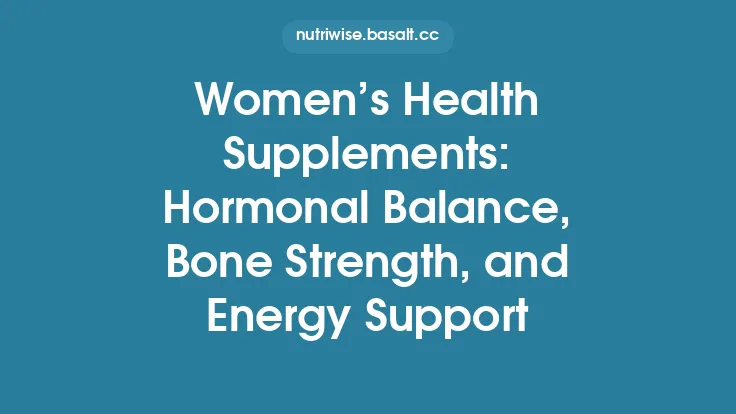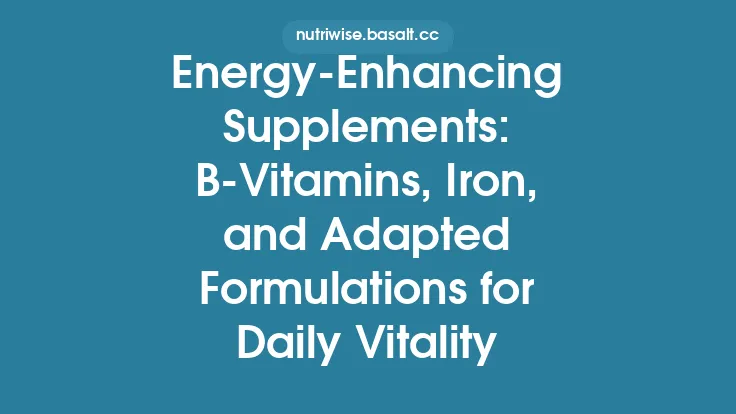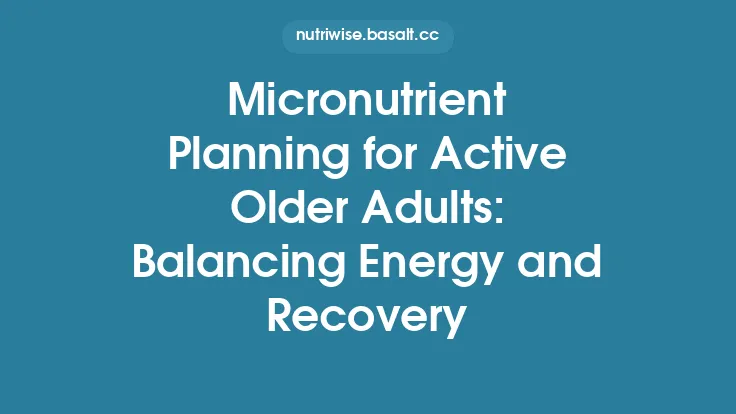Living at high altitude presents a unique set of physiological challenges that most of us never encounter in our day‑to‑day lives. The reduced barometric pressure means the air contains less oxygen per breath, prompting the body to adapt in order to maintain adequate tissue oxygenation. While natural acclimatization processes—such as increased breathing rate, elevated heart output, and the production of more red blood cells—are essential, they can be supported and sometimes accelerated with targeted nutrition. Specific micronutrients, phytochemicals, and bio‑active compounds can enhance the efficiency of oxygen transport, protect cells from the heightened oxidative stress that accompanies hypoxia, and sustain energy production when the body is working harder to meet its metabolic demands. This article explores the science behind these adaptations and offers evidence‑based supplement recommendations for anyone who calls high‑altitude environments home or spends extended periods there for work, recreation, or study.
Understanding the Physiological Demands of High‑Altitude Living
- Reduced Partial Pressure of Oxygen (PO₂): At 2,500 m (≈8,200 ft) the PO₂ drops by roughly 25 % compared with sea level, forcing the cardiovascular and respiratory systems to compensate.
- Acute Mountain Sickness (AMS) and Sub‑Acute Effects: Headaches, fatigue, and sleep disturbances are common during the first few days of exposure. Persistent hypoxia can lead to chronic mountain sickness, characterized by excessive erythrocytosis and pulmonary hypertension.
- Metabolic Shifts: Cells rely more heavily on glycolysis, and mitochondrial efficiency can be compromised, leading to a perceived drop in stamina and endurance.
- Oxidative Stress: Hypoxia paradoxically increases the production of reactive oxygen species (ROS) during reperfusion events (e.g., after a deep breath), which can damage lipids, proteins, and DNA if not adequately neutralized.
Understanding these mechanisms helps pinpoint which nutrients can be most beneficial.
Micronutrients That Optimize Oxygen Transport
| Nutrient | Primary Role at Altitude | Food Sources | Typical Supplemental Dose* |
|---|---|---|---|
| Iron (Fe) | Essential component of hemoglobin and myoglobin; supports erythropoiesis. | Red meat, lentils, fortified cereals. | 18 mg elemental iron daily (higher if ferritin <30 µg/L). |
| Copper (Cu) | Cofactor for ceruloplasmin, which oxidizes Fe²⁺ to Fe³⁺ for incorporation into transferrin. | Shellfish, nuts, seeds. | 0.9–1.5 mg daily. |
| Vitamin B₆ (Pyridoxine) | Required for heme synthesis and the conversion of tryptophan to serotonin, influencing breathing regulation. | Chickpeas, bananas, potatoes. | 1.3–2 mg daily. |
| Folate (B₉) | Works with B₁₂ and B₆ in red blood cell formation. | Leafy greens, legumes. | 400–600 µg DFE daily. |
| Vitamin B₁₂ (Cobalamin) | Critical for DNA synthesis in erythroid precursors. | Animal products, fortified plant milks. | 2.4–5 µg daily (higher if vegetarian). |
*Doses reflect typical adult recommendations; individuals with diagnosed deficiencies should follow clinician‑guided protocols.
Supporting Cellular Energy Production
- Coenzyme Q10 (Ubiquinone/Ubiquinol): Acts within the mitochondrial electron transport chain to improve ATP synthesis, which can be hampered by hypoxia. 100–200 mg of ubiquinol daily has been shown to enhance exercise capacity at altitude.
- L‑Carnitine: Facilitates the transport of long‑chain fatty acids into mitochondria for β‑oxidation, providing a steady energy source when carbohydrate metabolism is stressed. 500–1,000 mg per day, taken with meals, is commonly used.
- Creatine Monohydrate: Increases phosphocreatine stores, allowing rapid regeneration of ATP during high‑intensity bursts (e.g., climbing). A loading phase of 20 g/day split into 4 doses for 5–7 days, followed by 3–5 g/day maintenance, can be beneficial.
- Nitrate‑Rich Supplements (Beetroot Juice or Powder): Dietary nitrates are converted to nitric oxide (NO), which dilates blood vessels, improves oxygen delivery, and reduces the oxygen cost of exercise. 300–600 mg nitrate (≈70 ml beetroot juice) taken 2–3 hours before activity is effective.
Antioxidant Strategies to Counteract Oxidative Stress
- Vitamin C (Ascorbic Acid): Scavenges free radicals and regenerates vitamin E. 500–1,000 mg twice daily can help maintain plasma antioxidant capacity.
- Vitamin E (α‑Tocopherol): Protects cell membranes from lipid peroxidation. 200–400 IU daily, preferably as mixed tocopherols, is advisable.
- Alpha‑Lipoic Acid (ALA): A universal antioxidant that works in both aqueous and lipid environments and can recycle vitamins C and E. 300–600 mg per day, taken with meals, offers synergistic protection.
- Polyphenol‑Rich Extracts (e.g., Green Tea Catechins, Resveratrol): Provide additional ROS‑neutralizing activity and may improve endothelial function. 200–400 mg of standardized extracts are typical.
Adaptogenic Herbs for Enhanced Resilience
- Rhodiola rosea: Modulates the hypothalamic‑pituitary‑adrenal (HPA) axis, reduces perceived fatigue, and may improve oxygen utilization. 200–400 mg of a 3% rosavins/1% salidroside extract taken in the morning.
- Cordyceps militaris (or sinensis): Increases ATP production and has been shown in animal models to improve VO₂max under hypoxic conditions. 1,000–3,000 mg of a fruiting‑body extract daily.
- Panax ginseng: Supports cardiovascular function and can improve physical performance at altitude. 200–400 mg of a standardized ginsenoside extract taken before exertion.
Practical Supplement Timing and Stacking
- Morning Routine (upon waking):
- B‑complex (including B₆, B₉, B₁₂) + Vitamin C.
- Adaptogen (Rhodiola or Cordyceps) if you anticipate a demanding day.
- Pre‑Exercise (2–3 hours before activity):
- Nitrate source (beetroot).
- Creatine (if in loading phase) or L‑carnitine.
- CoQ10 (with a fat‑containing meal for better absorption).
- With Main Meals:
- Iron + Vitamin C (enhances absorption).
- Copper (often paired with iron‑rich meals).
- Fat‑soluble antioxidants (Vitamin E, ALA) with dietary fat.
- Evening (post‑exercise or before bed):
- Magnesium (300–400 mg) to support muscle relaxation and sleep quality, which is crucial for acclimatization.
- Additional antioxidant dose if oxidative markers are high (e.g., after a strenuous climb).
Safety, Contraindications, and Monitoring
- Iron Overload: Individuals with hemochromatosis or high ferritin (>150 µg/L) should avoid supplemental iron unless medically indicated.
- Copper‑Iron Interaction: Excessive copper can impair iron absorption; maintain a balanced ratio (approximately 1 mg Cu to 10 mg Fe).
- Vitamin K and Anticoagulants: High doses of vitamin E may potentiate anticoagulant effects; monitor INR if on warfarin.
- Adaptogen Sensitivities: Rhodiola can cause mild insomnia in some; take earlier in the day if this occurs.
- Kidney Function: High doses of creatine and certain antioxidants (e.g., high‑dose vitamin C) may stress renal clearance; periodic serum creatinine checks are prudent for those with pre‑existing kidney concerns.
- Pregnancy & Lactation: Although not the focus of this article, pregnant or nursing individuals should consult healthcare providers before initiating any of the above supplements.
Integrating Supplements with Lifestyle Practices
Supplements are most effective when paired with sound altitude‑specific habits:
- Gradual Ascent: Whenever possible, increase elevation by no more than 300–500 m per day after 2,500 m.
- Hydration: High altitude promotes diuresis; aim for 3–4 L of fluid daily, incorporating electrolytes to offset increased urinary loss.
- Balanced Diet: Emphasize whole grains, lean proteins, and colorful vegetables to naturally supply many of the highlighted nutrients.
- Sleep Hygiene: Use blackout curtains and consider short‑term melatonin (0.5–1 mg) if circadian rhythms are disrupted.
- Physical Conditioning: Regular aerobic training improves ventilatory efficiency and mitochondrial density, complementing the biochemical support from supplements.
By aligning nutritional supplementation with the body’s innate acclimatization pathways, residents and frequent visitors of high‑altitude regions can mitigate the adverse effects of hypoxia, sustain energy levels, and enjoy a higher quality of life amidst the mountains. As always, individual needs vary; consulting a qualified healthcare professional before beginning any new supplement regimen ensures personalized safety and optimal outcomes.





